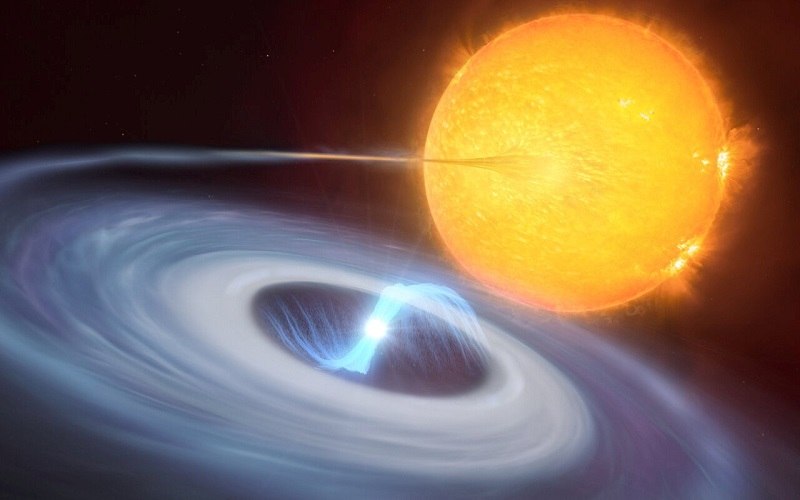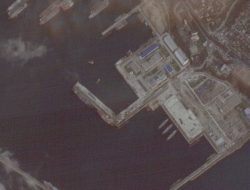
This artist’s impression shows a two-star system where stellar explosions called micronovae may occur.
5:55 JST, May 18, 2022
WASHINGTON (Reuters) — Astronomers have detected a previously unknown type of stellar explosion called a micronova involving thermonuclear blasts at the polar regions of a type of burned-out star called a white dwarf after it has siphoned material from a companion star.
The researchers said last month a micronova is by far the least powerful type of star explosions now known — less energetic than a blast called a nova in which a white dwarf’s entire surface blows up and tiny compared to a supernova that occurs during the death throes of some giant stars.
Micronovae are observed from Earth as bursts of light lasting about 10 hours. They were documented on three white dwarfs — one 1,680 light years away from Earth, one 3,720 light years away and one 4,900 light years away. A light year is the distance light travels in a year, 9.5 trillion kilometers.
“The discovery was an unexpected surprise. It goes to show just how dynamic the universe is. These events are fast and sporadic. Finding them requires looking at the right place at the right time,” said astronomer Simone Scaringi of Durham University in England, lead author of the study published in the journal Nature.
White dwarfs, among the densest objects in the universe, result from the collapse of a dying star’s core. They have the mass of our sun but are about the size of Earth in diameter. Most stars, including the sun, are destined to end their existence in this form.
Some white dwarfs are part of what is called a binary system, in an orbit with another star.
Micronovae happen in very specific binary systems — with a white dwarf star possessing a strong magnetic field and a low-mass normal star. The white dwarf’s gravitational pull can strip hydrogen gas from the companion star’s surface. The hydrogen then flows toward the white dwarf’s magnetic poles, similar to how Earth’s magnetic field channels the solar wind to our planet’s magnetic poles, causing the auroras.
At the base of accumulating columns of gas at the white dwarf’s poles, pressure and temperature rise, causing thermonuclear fusion that converts hydrogen into helium.
“Under the conditions in which this is triggered, this fusion is explosive, and the micronova occurs: A thermonuclear ‘bomb’ goes off,” said astronomer and study coauthor Paul Groot, who divides his time between Radboud University in the Netherlands and the University of Cape Town and South African Astronomical Observatory.
The explosion is localized and does not destroy the white dwarf. In fact, the micronova cycle can repeat itself.
“Only a very small percentage of the white dwarf participates in this explosion, roughly about one millionth of the surface area. Translated to the Earth this would be an area of about, say, the city of London,” Groot added.
Each micronova event burns through material the equivalent of one large asteroid, or just over one millionth of Earth’s mass, Scaringi said.
A micronova is similar to a nova, a thermonuclear explosion engulfing a white dwarf’s entire surface. With novae, the white dwarf lacks a strong magnetic field, meaning that hydrogen stolen from the companion star is distributed globally rather than concentrating at the poles. Novae can last for weeks or months, burning through about a million times more mass than micronovae, Scaringi said.
The researchers discovered the micronovae when analyzing data from NASA’s TESS space telescope. They used the European Southern Observatory’s Chile-based Very Large Telescope to confirm the explosions involved white dwarfs.
Some other types of stellar explosions include: A kilonova, when two neutron stars or a neutron star and a black hole merge; a hypernova, a kind of supernova involving a massive star exploding at end of its life cycle and collapsing to form a black hole; and a luminous red nova involving two stars merging.
"News Services" POPULAR ARTICLE
-

American Playwright Jeremy O. Harris Arrested in Japan on Alleged Drug Smuggling
-

Japan’s Nikkei Stock Average as JGB Yields, Yen Rise on Rate-Hike Bets
-

Japan’s Nikkei Stock Average Licks Wounds after Selloff Sparked by BOJ Hike Bets (UPDATE 1)
-

Japan’s Nikkei Stock Average Buoyed by Stable Yen; SoftBank’s Slide Caps Gains (UPDATE 1)
-

Japanese Bond Yields Zoom, Stocks Slide as Rate Hike Looms
JN ACCESS RANKING
-

Keidanren Chairman Yoshinobu Tsutsui Visits Kashiwazaki-Kariwa Nuclear Power Plant; Inspects New Emergency Safety System
-

Imports of Rare Earths from China Facing Delays, May Be Caused by Deterioration of Japan-China Relations
-

Tokyo Economic Security Forum to Hold Inaugural Meeting Amid Tense Global Environment
-

University of Tokyo Professor Discusses Japanese Economic Security in Interview Ahead of Forum
-

Japan Pulls out of Vietnam Nuclear Project, Complicating Hanoi’s Power Plans

























